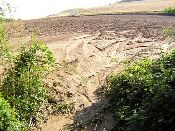| PESERA model application in the Portuguese study areas: Góis and Mação |
 |
|
T.C.J. Esteves (1), M.J. Kirkby (3), R.A. Shakesby (4), A.J.D. Ferreira (1), J.A.A. Soares (2), C.S.S. Ferreira (1), C.O.A. Coelho (2), C.P.M. Bento (1), and M.A. Carreiras (1) (1) Department of Environment, IPC - Escola Superior Agrária de Coimbra, Coimbra, 3040-316, Portugal, (3) School of Geography, University of Leeds, Leeds, LS2 9JT, United Kingdom, (4) Department of Geography, Swansea University, Swansea, SA2 8PP, United Kingdom, (2) Department of Environment and Planning, Universidade de Aveiro, Aveiro, 3810-193, Portugal
The Portuguese territory succumbs yearly to severe wildfires. The years 2003 and 2005 were particularly bad, with some of the worst wildfires seen in decades. They led to accelerated soil losses in these temperate subhumid ecosystems. There is the danger that these wildfires can cause land degradation. Consequently, there is an urgent need to develop integrated conservation approaches to reduce or prevent these degradational impacts. This paper presents the innovative effort being made in the FP6 EU-funded DESIRE research project (Desertification Mitigation & Remediation of Land: a global approach for local solutions to try to establish alternative land use and management conservation strategies in degradation-prone areas. In this paper, we are concerned with wildfireprone areas. The aim is to describe the application of a modified Pan-European Soil Erosion Risk Assessment (PESERA) model to two study areas in central Portugal, Góis and Mação, in order to predict runoff and erosion at a much larger spatial and temporal scales (regional and decadal, respectively) than is usually possible with field monitoring. Potentially, the modelling can improve land degradation predictions of water erosion. By using a 50-year historical climate time-series database, a simulation was made using the model. Management burns (every 2 years) and infrequent wildfires (100 years) applied to the model resulted in management burns leading to reduced soil erosion relative to infrequent wildfires, although the predicted soil losses for both types of fire are large compared even with measured losses obtained from small-scale field monitoring. From these results, the benefits, limitations, scope for improvement and application to future climatic scenarios of the model in a fire context will be analyzed and discussed.
|

Acknowledgement
The DESIRE project was
|
DESIRE brought together the expertise of
26 international research institutes
and non-governmental organisations.
This website does not necessarily
represent the opinion of the
European Commission. The European
Commission is not responsible for
any use that might be made of the
information contained herein. 
